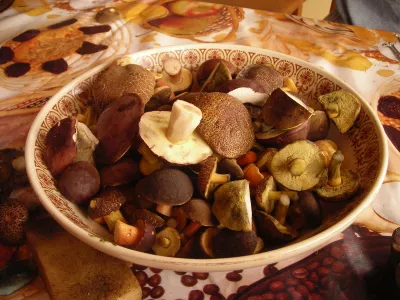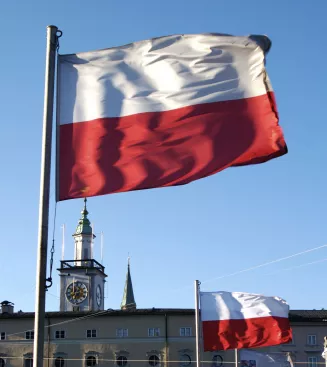Summary
- Poland’s National Flag
- Poland Traditional Dress – Polish Folk Costume
- Easter Eggs from Poland – Pisanki
- All Saint’s Day Poland – Day of the Dead
- Polish Dumplings – Pierogi
- Mushroom Picking in Poland – A Poland Seasonal Tradition
- Christmas in Poland – Poland Christmas Feast
- Wooden Boxes From Poland – Poland Folk Art
- Wooden Folk Carving from Poland – Wooden Toys from Poland
- Folk Music in Poland – Polish Traditional Music
- Poland’s World Heritage Sites
Poland’s National Flag
:max_bytes(150000):strip_icc():format(webp)/PolandFlag-56a39e715f9b58b7d0d2c9bd.jpg)
The national flag of Poland consists of a stripe of white on the top and a stripe of red on the bottom. These colors have been in use in the Polish flag for centuries. Before the 20th century, Poland’s flag featured its coat of arms, a white eagle on a red background. Some Polish flags still use the coat of arms; it can be found in a red crest centered in the white stripe of the current national flag.
The colors of Poland’s flag are often utilized to symbolize the country. You will see red and white featured in many cities’ coat of arms (for example, Warsaw’s coat of arms boasts a red shield on a white background). Furthermore, souvenirs from Poland are frequently created in these iconic colors.
Polish Flag Day was officially established in 2004 and is observed on May 2. Although Poland’s flag may be more prominently displayed on this day, it can always be seen at significant government buildings like the Presidential Palace in Warsaw.
Poland Traditional Dress – Polish Folk Costume

Traditional Polish folk costumes differ in design depending on the region but are typically characterized by bright colors and intricate embroidery. These vibrant costumes are still worn for special occasions, such as weddings, or in rural areas by older generations. The styles of traditional dress in Poland vary widely, with distinctive headdresses ranging from hats to flower wreaths. Moreover, the variety of fabric colors, alongside the use of aprons, vests, and ribbons, highlight the rich cultural heritage linked to the region of origin.
Easter Eggs from Poland – Pisanki

Dyed and decorated Easter eggs, known as pisanki in Poland, are steeped in tradition. This practice of egg decorating dates back centuries and varies by region, much like traditional Polish attire. The designs and coloring techniques have been passed down from mother to daughter, reflecting the cultural significance attached to them. Originally linked to Polish pagan traditions, these eggs symbolize spring, renewal, fertility, and eternity.
Easter in Poland is a highly anticipated holiday, filled with fairs, markets, special foods, and various customs. During this festive time, beautifully crafted Polish Easter eggs can be found in abundance at local fairs and markets.
All Saint’s Day Poland – Day of the Dead

On All Saint’s Day (November 1), Polish cemeteries come alive with decoration, adorned with flowers and lit candles. These candles are specially designed to burn for extended periods, offering light to guide spirits through the night. When evening falls, hundreds of candles illuminate Poland’s cemeteries, creating a poignant atmosphere.
This recognition of All Saint’s Day is rooted in the Roman Catholic tradition, and many Polish individuals view their identity as Roman Catholics as an inseparable aspect of their Polish heritage.
Polish Dumplings – Pierogi

Pierogi are delectable dumplings that can be stuffed with a wide variety of ingredients – from potatoes and meat to onions and cheese. Traditionally, they are served with a dollop of sour cream, adding a delightful creaminess. Authentic Polish restaurants always feature pierogi on their menus. Moreover, for dessert, enjoy sweet pierogi filled with berries or jam, providing a delicious conclusion to any meal.
Mushroom Picking in Poland – A Poland Seasonal Tradition

Mushrooms are a cherished aspect of Poland’s national cuisine. Unlike the bland varieties often found in Western supermarkets, mushrooms that grow organically in Poland are bursting with flavor. Consequently, many Polish families engage in mushroom foraging, making it a delightful tradition that incorporates all family members.
The autumn mushroom season provides an opportunity for restaurant chefs to showcase Polish mushroom delicacies. Therefore, if you visit Poland during the fall, be sure to sample exquisite dishes that highlight this seasonal treasure.
Christmas in Poland – Poland Christmas Feast

Polish Christmas celebrations, akin to other Eastern European traditions, commence with a family feast on Christmas Eve. Families gather together for this momentous occasion. Traditionally, 12 symbolic dishes are served in honor of the 12 apostles. Historically, Christmas has been a time for fortune-telling and superstition, and many Polish families continue to observe these ancient beliefs, not only for fun but also as a means of recalling cherished past Christmases.
Wooden Boxes From Poland – Poland Folk Art

Carved wooden boxes in traditional folk styles are excellent souvenirs from Poland. Traditionally, these woodcrafts were made during the winter months when farming families sought to occupy their time until spring. Some artisans became renowned for their exceptional box-making and decorating skills. The symbols carved on these boxes were believed to bring prosperity or protection, and brides’ dowry chests were often ornately decorated with these motifs.
Wooden Folk Carving from Poland – Wooden Toys from Poland

Folk carvings from Poland also make memorable gifts. They often showcase the humorous aspects of Polish folk tradition and culture while displaying the unique character of the individual artists. Peasant figures and likenesses of animals are carefully carved by hand, painted, and sold at souvenir shops and markets.
Folk Music in Poland – Polish Traditional Music

Interest in Poland’s traditional folk music has undergone a revival both domestically and internationally. The country now hosts numerous traditional folk music festivals that showcase authentic music from Poland’s historical past. These events feature not only the music but also incorporate dances and folk costumes into their performances. In some cases, groups compete against each other, with experts in traditional folk music, dance, and costume presiding over the performances.
Poland’s World Heritage Sites

Poland’s World Heritage Sites are internationally recognized for their cultural and historical importance. These sites encompass medieval towns, natural landscapes, religious locations, and more, each telling profound stories about the events, individuals, ideas, and ways of life that have shaped Poland’s rich history.





